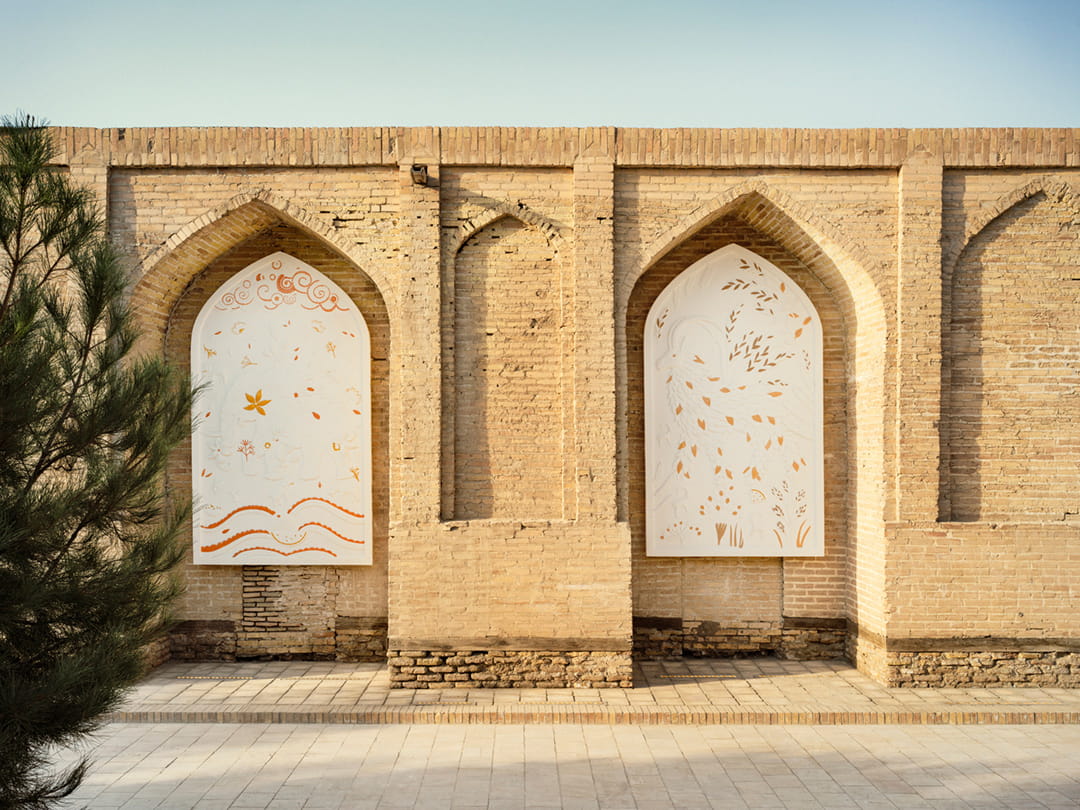
Art Biennial Reviving the Ancient City of Bukhara, Uzbekistan
Uzbekistan’s inaugural biennial reactivates an ancient stop on the Silk Road through artworks jointly created by international and Uzbek artists.
Above: Louis Barthélemy of France collaborated with Abdurahim Umarov of Uzbekistan on “Fantastic Creatures of the Silk Road” à la the Khoja Kalon Mosque.
The distinctive, blue-domed minarets of Uzbekistan’s ancient city of Bukhara pierce the sky proudly. Examples of Islamic architecture once marked Bukhara as a major cultural center for the Muslim world, a place for trade, scholarship and religion for centuries.
Today, for the first time in the city’s history, new works of contemporary art are positioned throughout its 2,000-year-old historical center, a UNESCO World Heritage Site. They comprise the inaugural Bukhara Biennial, staged by the Uzbekistan Art and Culture Development Foundation (ACDF). The event, titled “Recipe for Broken Hearts,” explores the healing power of art and culture, especially through communal participation. The theme is so named for its roots in Uzbek culture and cuisine.
“I wondered [what] the world could feel like if we all took our talents, as [Islamic Golden Age philosopher-physician] Ibn Sina did, to try to heal the people around us by creating things that did not exist before,” explains Diana Campbell, the biennial’s artistic director.
It sees more than 70 new commissions, all produced in Uzbekistan through collaborations between international artists and local artists and artisans, installed within the city’s madrasas, or schools; mosques; bazaars; and along the pedestrianized streets. The works offer visitors a chance to see the old city in a new light: where historical structures mingle with new creations, revitalizing the storied city through art.
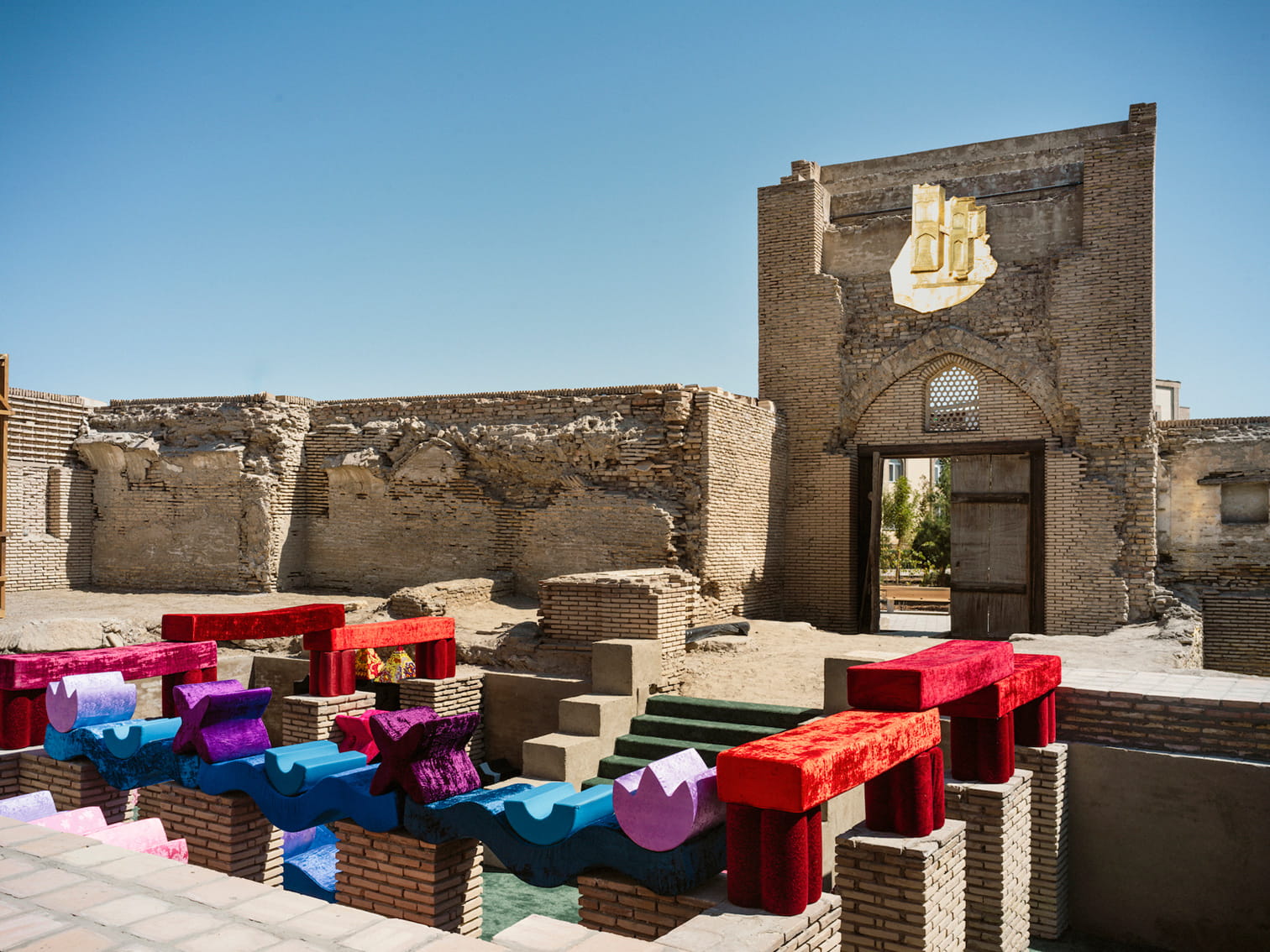
The Ayozjon Caravanserai contains a piece by Wael Shawky of Egypt and Jurabek Siddikov of Uzbekistan.
For the biennial, Lebanese architect Wael Al Awar restored much of the city as part of an ACDF initiative. “The city was constantly in transition,” says Al Awar. “My role was to knit the urban fabric together and create a public space.” His vision focused on reviving the cultural district, a 30,000-square-meter (322,917-square-foot) area connecting the city’s caravanserais—once roadside inns and resting places for travelers, caravans and merchants, particularly along trade routes like the Silk Road—madrasas and public spaces.
“Our aim has been twofold: to protect the historical fabric and to give the spaces a new, useful life,” says Gayane Umerova, the chairperson of ACDF and commissioner of the biennial, during her opening address to an audience of Uzbeks and journalists, art collectors and curators from around the world. “In partnership with international experts, including UNESCO, we have focused on reactivating our most treasured landmarks as places for making, learning and exchange.”
The unique character of the Bukhara Biennial—the first ever in Central Asia—lies not only in its evocative usage of ancient structures to display new artistic creations but in pairing Uzbek artists and artisans with international artists.
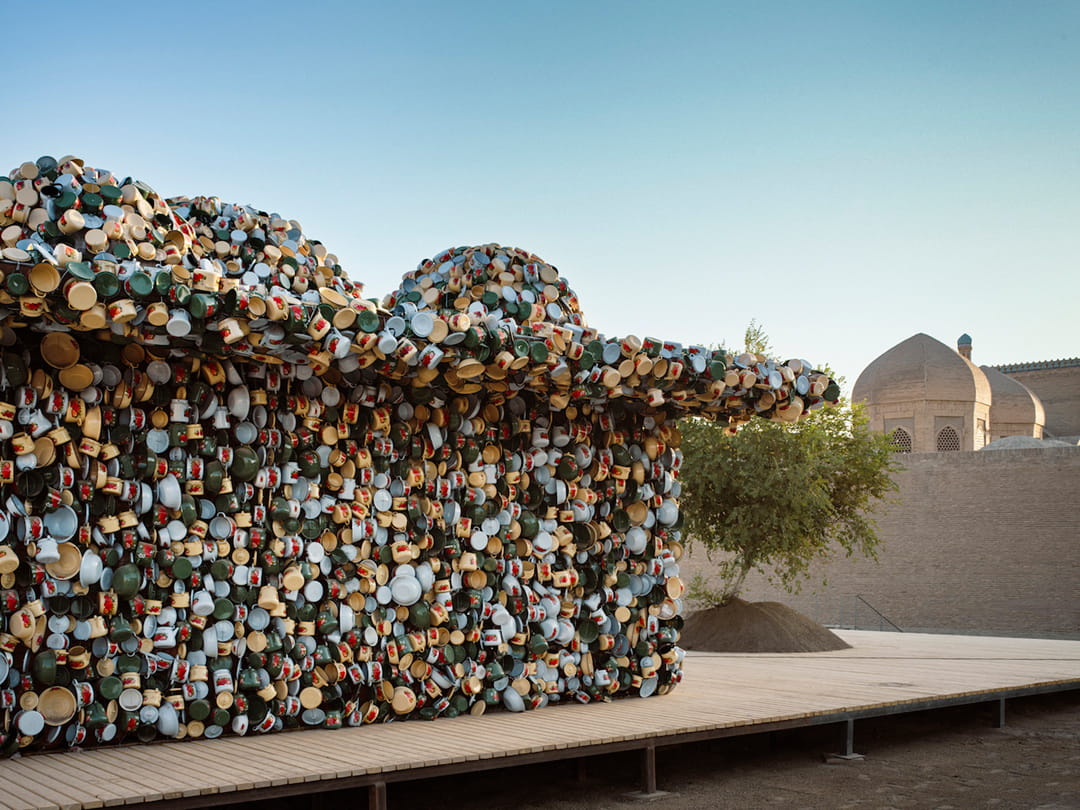
Subodh Gupta’s “Salt Carried by the Wind,” with tableware by Baxtiyor Nazirov of Uzbekistan, is among biennial artworks that reflect the theme of communal gatherings over food.
Every work is site specific and focused prominently on incorporating the traditional crafts of weaving, tapestry, ceramics and mosaic—all of which continue at the heart of the Uzbek creative scene and reference Uzbek traditions and rituals. The artworks guide the visitor to the city’s ancient structures, such as the 11th-century Rabat-i Malik caravanserai; the city’s bazaar; the Rashid Madrasa, a historical Islamic educational institution; the Gavkushon Madrasa, a 16th-century center for learning; and the 16th-century Khoja Kalon Mosque.
Aligned with the biennial’s theme, many artworks reflect ideas related to communal gatherings over food. One example is Subodh Gupta’s pavilion “Salt Carried by the Wind” (2024-25), located outside the Ayozjon Caravanserai, in an area that once welcomed Indian merchants, drawing parallels to Gupta’s own heritage.
The pavilion echoes the architectural form of the Magoki Attori, the oldest standing mosque in Central Asia. Inside guests could gather and share plov, the rice-based national dish of Uzbekistan, cooked by Gupta and served on plates made by master Uzbek ceramicist Baxtiyor Nazirov—works that are in deliberate contrast with the mass-produced Soviet-era enamel pots, commonly found in Uzbek homes, that decorate the structure.
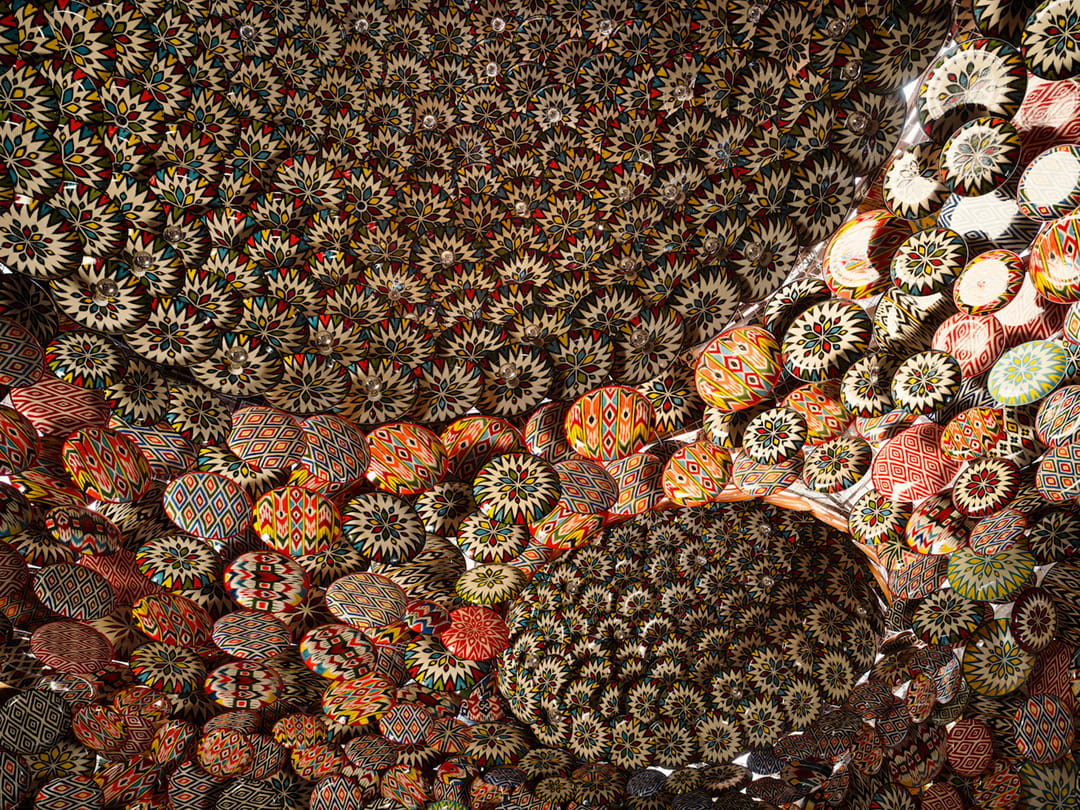
The interior domed ceiling of “Salt Carried by the Wind.”
Nearby is the Ayozjon Caravanserai , among the main locations of the biennial and one of four interconnected 18th- and 19th-century caravanserais in Bukhara. Inside is a glistening structure by Egyptian artist Wael Shawky, made with Uzbek artisan Jurabek Siddikov, that reflects Bukhara's legacy as “The Copper City,” or Madinat al-Sufriya. The installation incorporates copper panels on the ground with a palm tree shooting up amid them, reverberating the rich history of storytelling from Persian and Central Asian manuscripts. In Uzbekistan, copper has long been associated with healing and storytelling. The metal is revered for its perceived ability to transmit energy—even warding off negativity.
“It was quite challenging since I usually work with traditional embossing, a form of metal engraving,” says Siddikov about creating the work. “For generations, we have made only jugs, trays and plates. Before collaborating with Wael, I had created various kinds of panels, but this was my first time making a design based on a miniature painting.”
In “Blue Room” (2024-2025), a startling immersive ceramic installation occupying the former prayer room of Gavkushon Madrasa, an architectural ensemble built in 1570 with a traditional courtyard, classrooms, a prayer room and living quarters for students, Bukharian ceramicist Abdulvahid Bukhoriy has covered the room entirely in handcrafted blue tiles. The blue creates a sensation of being immersed in emotions. At the center of the room is an elaborate suspended brass and copper sculpture produced in collaboration with Siddikov, its circular forms inspired by fish forms found in Central Asian ceramic traditions.
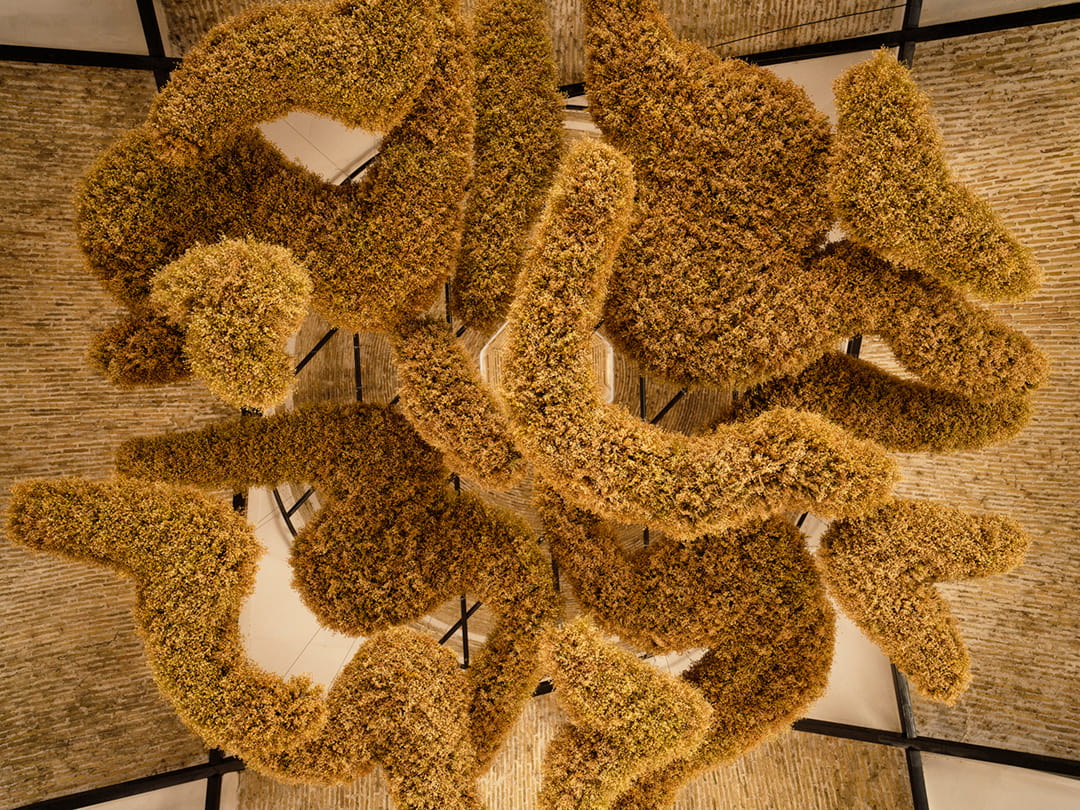
Uzbek artists Munisa Kholkhujaeva and Anton Nozhenko merge traditional craft and heritage with contemporary forms in “Bloom and Decay,” a chandelier of medicinal flowers.
“Abdulvahid was very pleased, and I myself was truly delighted because this was our first experiment combining ceramics with copper and brass,” says Siddikov of the collaboration. “After this, we agreed that we should create something else just as striking. When two masters join forces, their shared spirit is invested in the piece. That is why this chandelier feels so meaningful to me. To put it briefly, my emotions about it are beyond words. As soon as we finished and hung it, I immediately compared the composition with a multiverse.”
Ideas of transcendence and healing through creations that merge traditional craft and heritage with contemporary forms could be found in “Bloom and Decay,” a chandelier of medicinal flowers suspended from the interior dome of the bazaar. Uzbek artists Munisa Kholkhujaeva and Anton Nozhenko drew on Ibn Sina's medicinal plant studies and ancient Central Asian rituals to reflect how the gifting of flowers celebrates life, courtship, sickness, life and death.
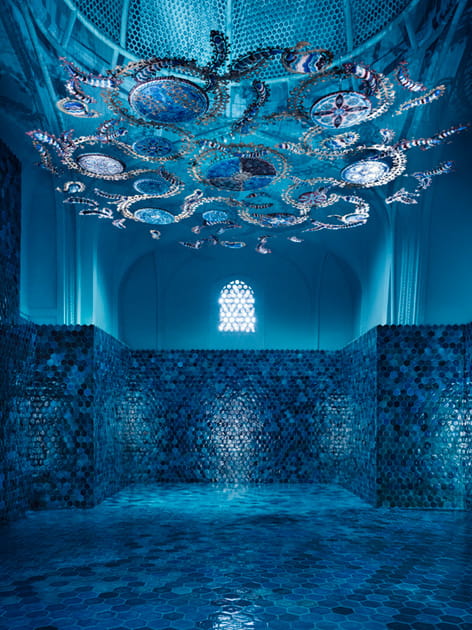
Bukharian ceramicist Abdulvahid Bukhoriy covered the former prayer room of Gavkushon Madrasa in handcrafted tiles for “Blue Room,” a ceramic installation he created with fellow Uzbek artist Siddikov.
On the outer wall of Khoja Kalon Mosque, Louis Barthélemy, in collaboration with master ganch (a mixture of gypsum and clay) craftsman Abdurakhim Umarov, created “Fantastic Creatures of the Silk Road” (2024-2025), panels of imaginary creatures inspired by ancient, illustrated manuscripts where multiple stories are told through a single image. “I loved the niches on the outer mosque and wanted to expose something that would match the architecture,” says Barthélemy, recounting how, though he and Umarov speak different languages, they created a procession “of whimsical creatures that are also symbols of resilience, reinvention and beauty: remedies for a broken heart.”
The inaugural Bukhara Biennial, which runs through November 20, is as much about renewal and revival as it is emphasizing the importance of remembering history. Approximately 40 percent of Uzbekistan’s population is younger than 35. For many, viewing such artworks offers creative opportunities that have potential, like the biennial has demonstrated, to unite traditions of the past with the innovative spirit of the present.
You may also be interested in...
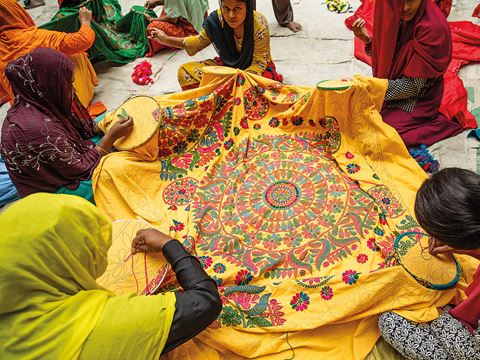
Nakshi Kantha Embroidery: Tales of Heritage and Revival
Arts
History
A traditional form of quilting in Bangladesh in which women embroider family history, love and memory into the fabric is blanketing markets locally and beyond.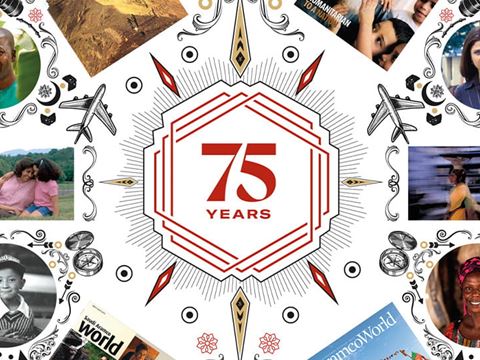
AramcoWorld: 75 Years of Visual Storytelling Through Photography
Arts
History
Part 2 of our series celebrating AramcoWorld’s 75th anniversary this year highlights “visual vagabonding”—the magazine’s expanded use of vibrant images over the decades to fulfill the mission of cultural connection.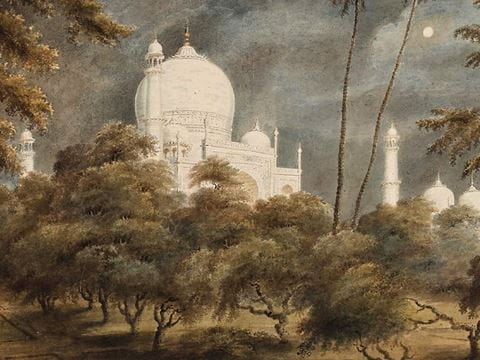
How Historical Paintings of Taj Mahal Changed Perceptions of India
Arts
History
The depiction of the Taj Mahal in the works of Indian and British artists in the 1800s helped bolster enthusiasm for the country & rsquo;s rich culture, architecture and society. One such painting, & ldquo; The Taj Mahal by moonlight,& rdquo; stirred a bidding frenzy at a recent auction, and some experts argue that such paintings have helped change perceptions of India in the West.